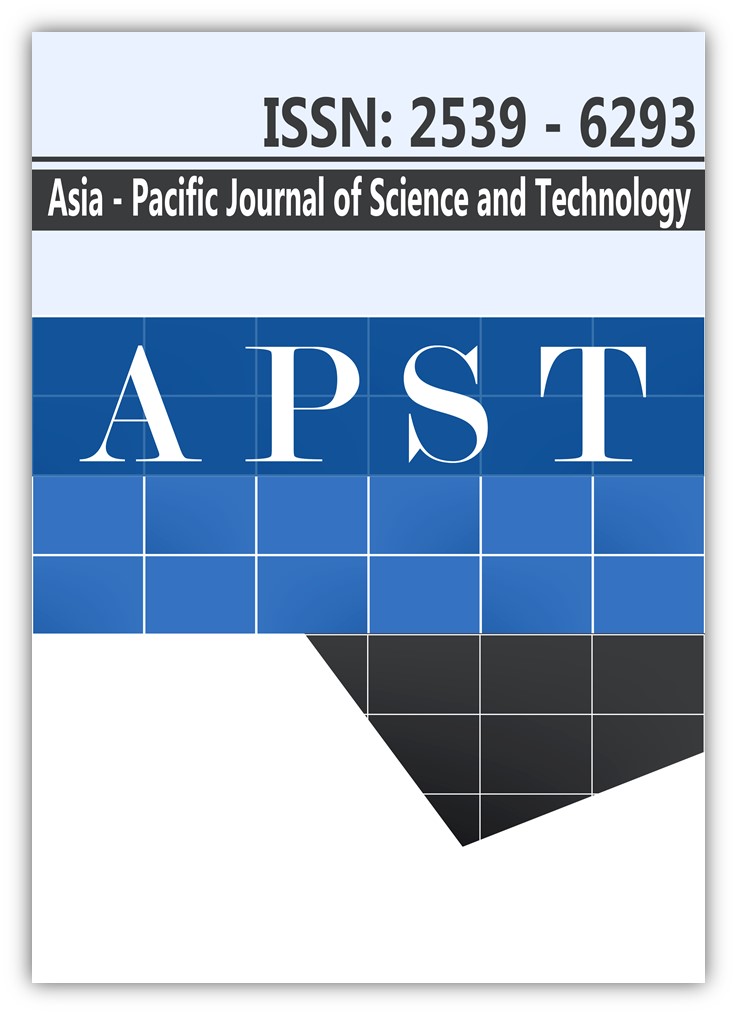Effective use of mobile phone application for supporting health care
Main Article Content
Abstract
This research aims to apply innovative technology to support the health of Thai people. In the present day, technology has become a part of our daily lives in the form of devices such as computers, smartphones and other gadgets. Innovative technologies allow people to make their lives easier. The technologies have been rapidly adopted and applied with a wide variety of both hard and soft skills. The purpose of this research is to study the effective use of mobile phones to support user health. A prototype of a mobile application to promote Thai people’s health was developed. It consists of three main parts: a) to promote healthy food consumption for individuals, b) to support appropriate work outs for individuals, and c) to aid people to quit smoking. The control group of participants was trained to use the prototype application whilst the experimental group learned to use the prototype by themselves. The participants selected for the experiment differ in gender and age, have different education and job backgrounds and also unequal monthly earnings. 33.82% of trained users could use the application and achieve the objectives of parts 1 and 2. For part 3, there were a total of 19 participants in the group who were smokers, 15% of them were able to use the application successfully and achieve the objectives. We compared the effectiveness of the participants who were and were not trained in how to use the application. Moreover, we used a questionnaire to collect data and feedback on the use of the application in order to support the outcome of the three main parts. The questionnaire was selectively distributed and there were 12 respondents. In order to gain insights into the participants’ use of the application, open and closed questions were employed in the questionnaire. The questions covered the subjects of Usability, Availability, Reliability, Accessibility, and Performance. The results revealed that the participants had positive attitudes towards the use of this mobile application. They agreed that the application encouraged and motivated them to improve their health. A number of other possible approaches for further investigation have been identified. In this paper, we also provide the research outcomes and what needs to be done to improve the approach in order for it to be more beneficial. We intend to extend the prototype to cover all activities in daily life. Using sophisticated visualization techniques will help to make the application work more efficiently as well.
Article Details
References
[2] Ozdalga E, Ozdalga A, Ahuja N. The smartphone in medicine: A review of current and potential use among physicians and students. J Med Internet Res. 2012;14(5):e128.
[3] Markle Foundation Personal Health Working Group. Connecting for health: A public-private collaborative. New York: Markle Foundation; 2003.
[4] Tang PC, Ash JS, Bates DW, Overhage JM, Sands DZ. Personal health records: Definitions, benefits, and strategies for overcoming barriers to adoption. J Am Med Inform Assoc. 2006;13(2):121-126.
[5] Jirapanthong W. Computer technology to improve medical information in Bangkok, Thailand. J Rev Glob Econ. 2017;6:285-292.
[6] Yamin CK, Emani S, Williams DH, Lipsitz SR, Karson AS, Wald JS, et al. The digital divide in adoption and use of a personal health record. Arch Intern Med. 2011;171(6):568-574.
[7] Ventola CL. Mobile devices and apps for health care professionals: Uses and benefits. Pharm Ther. 2014;39(5):356-364.
[8] NECTEC. Personal Health Record: PHR [Internet]. 2017 [cited 2018 Mar 15]; Available from: https://www. nectec.or.th/innovation/innovation-software/phr.html.
[9] Health Resources and Services Administration (HRSA). RSA health IT adoption toolkit [Internet]. 2018 [cited 2018 Mar 15]; Available from: https://www.hitechanswers.net/ehr-adoption-2/
[10] Hsu J, Huang J, Kinsman J, Fireman B, Miller R, Selby J, et al. Use of e-health services between 1999 and 2002: A growing digital divide. J Am Med Inform Assoc. 2005;12(2):164-171.
[11] Qadri MT, Asif M. Automatic number plate recognition system for vehicle identification using optical character recognition. In: 2009 International Conference on Education Technology and Computer. IEEE; 2009. p. 335-338.
[12] Jones KR, Lekhak N, Kaewluang N. Using mobile phones and short message service to deliver self-management interventions for chronic conditions: A meta-review. Worldviews Evidence-Based Nurs. 2014;11(2):81-88.
[13] Patel S, Jacobus-Kantor L, Marshall L, Ritchie C, Kaplinski M, Khurana PS, et al. Mobilizing your medications: An automated medication reminder application for mobile phones and hypertension medication adherence in a high-risk urban population. J Diabetes Sci Technol. 2013;7(3):630-639.
[14] Athilingam P, Labrador MA, Remo EFJ, Mack L, San Juan AB, Elliott AF. Features and usability assessment of a patient-centered mobile application (HeartMapp) for self-management of heart failure. Appl Nurs Res. 2016;32:156-163.
[15] Perera AI, Thomas MG, Moore JO, Faasse K, Petrie KJ. Effect of a smartphone application incorporating personalized health-related imagery on adherence to antiretroviral therapy: A randomized clinical trial. AIDS Patient Care STDS. 2014;28(11):579-586.
[16] EF Education First Ltd. EF English Proficiency Index. [Internet]. 2018 [cited 2019 Jan 9]. Available from: https://www.ef.co.th/ /~/media/centralefcom/epi/downloads/full-reports/v8/ef-epi-2018-english.pdf
[17] Google. Android Developers [Internet]. 2018 [cited 2018 Feb 5]. Available from: https://developer. android.com/index.html
[18] Cronbach LJ. Coefficient alpha and the internal structure of tests. Psychometrika. 1951;16(3):297–334.
[19] The Household Socio-Economic Survey, National Statistical Office, Ministry of Information and Communication Technology [Internet]. 2016 [cited 2017 Feb 2]. Available from: https://service.nso.go.th/nso/web/statseries/statseries11.html


